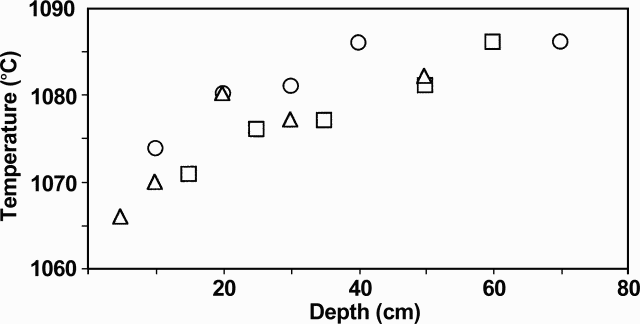Report on Etna (Italy) — June 1999
Bulletin of the Global Volcanism Network, vol. 24, no. 6 (June 1999)
Managing Editor: Richard Wunderman.
Etna (Italy) Lava-flow temperature measurements
Please cite this report as:
Global Volcanism Program, 1999. Report on Etna (Italy) (Wunderman, R., ed.). Bulletin of the Global Volcanism Network, 24:6. Smithsonian Institution. https://doi.org/10.5479/si.GVP.BGVN199906-211060
Etna
Italy
37.748°N, 14.999°E; summit elev. 3357 m
All times are local (unless otherwise noted)
During the winter of 1998-99, Southeast Crater underwent a series of short eruptions. On 4 February 1999 a similar outbreak led to fracturing of the SE cone with subsequent lava flows to the NNE and SSE (observation by Giuseppe Scarpinati). The SE flow developed a lava field between 2,900 and 2,800 m elevation on the rim of the Valle del Bove (BGVN 24:05), with numerous branches that nearly reached its bottom at about 2,000 m elevation. This mild effusive activity was characterized by very small and slow degassed lava flows coming from ephemeral vents through the superficially congealed crust of the field.
Temperature measurements were carried out on lavas from several of these effusive vents during the first days of April. Special thanks are due to Antonio and Orazio Nicoloso and the Etnean Guides for assistance in the field. Consumable "Temtip" Pt / Pt-10%Rh thermocouples were used following a procedure described in Archambault and Tanguy (1976). The maximum lava temperature recorded at depths of 40-60 cm within the fluid lava was 1,085 ± 5°C (figure 78), slightly higher than that measured during the last two major flank eruptions of 1983 and 1991-93 (1,070-1,080°C). As already shown in Archambault and Tanguy (1976), such small lava flows showed a strong thermal gradients, so that measurements made at 5-15 cm depth give results 10-15°C lower than the true internal temperature (figure 79). This means that devices reaching only the superficial parts of the flows are unsuitable for such temperature measurements.
 |
Figure 78. Histogram showing the number of Etna lava measurements at each temperature; the 16 measurements were taken at depth on fluid lava. |
 |
Figure 79. Lava flow temperatures measured at Etna during early April plotted versus depth. Different symbols (circles, squares, and triangles) represent different sets of measurements. |
Although relatively low for a trachybasalt (or basaltic hawaiite) lava, the temperature of 1,085°C is consistent with their high crystal content of ~40% phenocrysts. As usual in recent Etna lavas, these phenocrysts consist of plagioclase, clinopyroxene, olivine and titanomagnetite lying in a glassy alkaline groundmass.
Reference. Archambault, C., and Tanguy, J.C., 1976, Comparative temperature measurements on Mount Etna lavas: Journal of Volcanology and Geothermal Research, 1, 113-125.
Geological Summary. Mount Etna, towering above Catania on the island of Sicily, has one of the world's longest documented records of volcanism, dating back to 1500 BCE. Historical lava flows of basaltic composition cover much of the surface of this massive volcano, whose edifice is the highest and most voluminous in Italy. The Mongibello stratovolcano, truncated by several small calderas, was constructed during the late Pleistocene and Holocene over an older shield volcano. The most prominent morphological feature of Etna is the Valle del Bove, a 5 x 10 km caldera open to the east. Two styles of eruptive activity typically occur, sometimes simultaneously. Persistent explosive eruptions, sometimes with minor lava emissions, take place from one or more summit craters. Flank vents, typically with higher effusion rates, are less frequently active and originate from fissures that open progressively downward from near the summit (usually accompanied by Strombolian eruptions at the upper end). Cinder cones are commonly constructed over the vents of lower-flank lava flows. Lava flows extend to the foot of the volcano on all sides and have reached the sea over a broad area on the SE flank.
Information Contacts: Roberto Clocchiatti, Lab. Pierre Sue, CEA Saclay, France; Charles Rivière, CGE, France; Santo La Delfa, Giuseppe Patanè, and Jean-Claude Tanguy, University of Catania, Italy.

